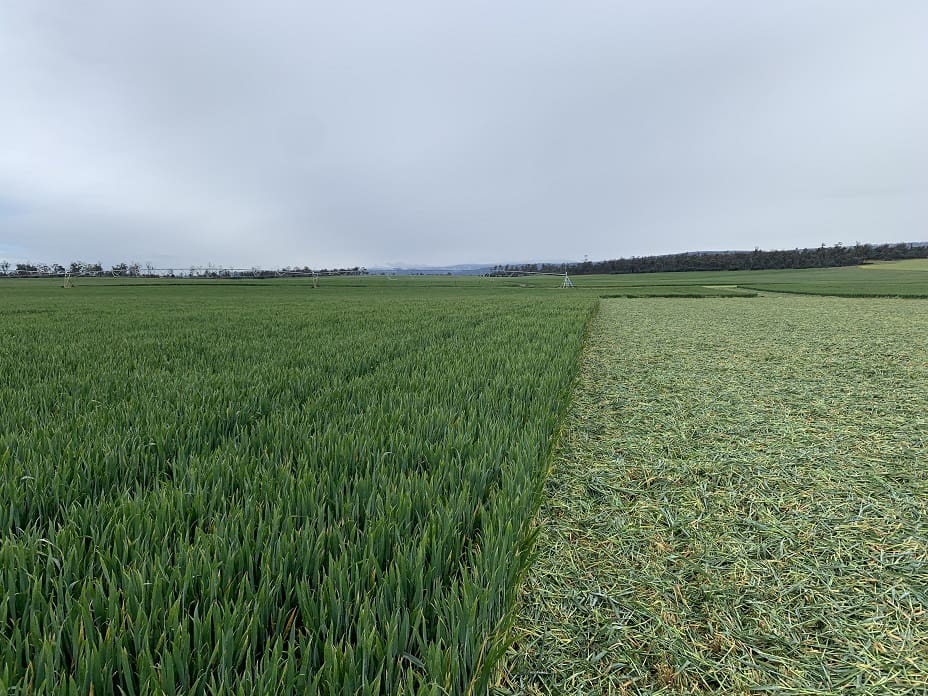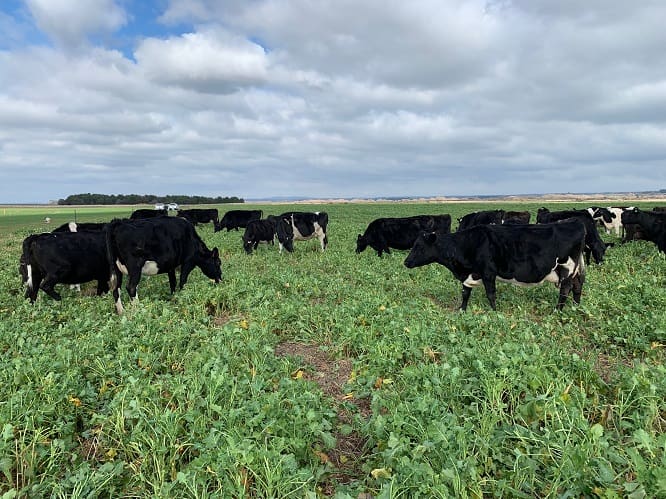THE wettest April in 60 years is likely to cause growers in Tasmania’s high rainfall zone some unique challenges when it comes to controlling annual ryegrass, the Australian grain industry’s number one weed.
Blow-outs are mostly in wet years and in paddocks with other underlying issues where ryegrass can take advantage of any gaps or areas of lower crop vigour.
Many growers are finding that ryegrass is particularly difficult to manage in winter cereal and canola crops where the long cool season allows multiple germinations of ryegrass and the wet conditions reduce the residual benefits of pre-emergent herbicides.
WeedSmart southern agronomist Greg Condon said creative farmers and agronomists were addressing the problem head on and finding ways to implement the WeedSmart Big 6 weed management tools to stop seed set and drive down weed numbers.
“Farmers need to operate in a low-weed environment so they have more options in their crop and livestock decisions,” he said.
“The principles of crop diversity, crop competition and mixing and rotating herbicide modes of action are central to keeping farming systems profitable.
“The creativity comes in with the problem-solving process needed to apply these principles in challenging environments. The practices that have been developed in other high rainfall zones do not always apply directly to the Tasmanian farming systems.”
WeedSmart Big 6
Growers and agronomists can use the WeedSmart Big 6 to keep ryegrass numbers under control while maintaining maximum flexibility in their cropping program.
Mr Condon said all the tactics would work in the Tasmanian high rainfall zone, with the exception of harvest weed seed control.
“Growers in the region have a distinct advantage when it comes to diversity in their farming system and this needs to drive the use of different weed control methods to keep the weeds guessing – using both herbicide and non-herbicide tools,” he said.
“Unfortunately, harvest weed seed control is far less effective in the Tasmanian cropping zones than it is in other high rainfall zones.
“This is because a large percentage of the ryegrass that germinates in the crop will shed its seed before harvest. Some growers may still find value in this tactic to collect the seed from the later cohorts of the weed but it just isn’t as cost-effective as it is in other areas.”
Even without harvest weed seed control as a mainstay option, growers can still implement a three or four year ‘war on weeds’ program to drive down the ryegrass seed bank.
“To start with, tactics such as spring cropping, fodder crops and triple break crops can be used to maximise the efficacy of available herbicides and reduce ryegrass germinations,” Mr Condon said.
“When it comes to herbicides it is critical that a plan is put in place to mix and rotate herbicides across the whole crop sequence.
“In-crop herbicides are scarce and products like clethodim are registered for use in many crops so it is easy to keep using it, but we know that quickly leads to resistance problems.”
Having diversity of crops in the system only helps with weed control if it is used as a way to rotate chemistry.
Testing the weeds for their susceptibility to single products and mixes of herbicides allows growers to plan ahead with more confidence. Double knocking each herbicide application preserves the available chemistry, particularly glyphosate.
Growers can also take advantage of ryegrass’ poor competitive ability. When placed in a competitive environment, ryegrass sets less seed, reducing the pressure of this weed on farming system decisions.
“Crop agronomy has a major impact on competitiveness,” Mr Condon said.
“The choice of crop, solid plant establishment, sowing early with a robust pre-emergent herbicide and attending to any soil constraints all swing the advantage toward the crop and away from the weeds.”
Final tactic
The final tactic that growers can implement is stopping weed seed set using hay and silage, crop-topping in canola or spraying under the cutter bar when swathing, or using camera-guided shielded sprayer technology to target weeds growing in the inter-row.
Southern Farming Systems’ Tasmanian Projects and Trials manager Ian Herbert said fodder crops and livestock played a critical role in managing ryegrass on many Tasmanian farms.
“Growers can plant fodder crops directly after grain harvest, graze these fodder crops through winter, while allowing multiple germinations of ryegrass to occur, and then remove these plants using broad spectrum herbicides and or cultivation prior to planting a grain crop in spring,” he said.
“This tactic reduces the pressure on selective herbicides and changes the timing of when ryegrass is controlled, compared to years where the paddock is in a cereal production phase. Cultivation is often needed to remove the deep pugging from livestock, which often occurs during our wet winters.”

Cutting weedy areas of the crop for hay is a highly effective tactic that can reduce the impact of a weed blow-out.
Integrated approach
Michael Chilvers is one grower who is embracing an integrated approach to managing ryegrass on his 1200-hectare farm south of Launceston, where he runs a diverse cropping enterprise of around 300ha of grain production along with intensive lucerne hay, potato and hybrid seed production.
Mr Chilvers said the exceptionally wet autumn across much of the high rainfall zone, and particularly in their region, was going to put heavy pressure on the pre-emergent herbicides applied at planting.
“Incorporation of pre-em herbicides is critical and often not easy to achieve,” he said.
“Unfortunately, the newly released pre-em products are probably not going to be an option for us in very wet seasons so we need to focus on getting the most out of the existing products.”
Mr Chilvers is also very aware of the heavy reliance on Group A herbicides such as clethodim across his farming system and is doing what he can to rotate away from this key mode of action at every opportunity.
“Not only do we use it frequently, we also know that its efficacy can be compromised in our environment through a long cool growing season, which means we are running a real risk of losing it if we don’t adopt a more diverse approach to managing ryegrass,” he said.

Livestock can play an important role in weed management and there are many options available to growers.
Source WeedSmart, www.weedsmart.org.au

HAVE YOUR SAY